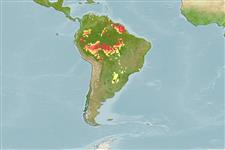Classification / Names
Common names | Synonyms | Catalog of Fishes (gen., sp.) | ITIS | CoL | WoRMS | Cloffa
Elasmobranchii (sharks and rays) >
Myliobatiformes (Stingrays) >
Potamotrygonidae (River stingrays)
Etymology: Potamotrygon: Greek, potamos = river + Greek, trygon = a sting ray (Ref. 45335).
Environment / Climate / Range
Ecology
Freshwater; benthopelagic; dH range: 10 - ?; potamodromous (Ref. 51243). Subtropical; 24°C - 26°C (Ref. 12468), preferred ?
South America: Paraná-Paraguay River basin.
Size / Weight / Age
Maturity: Lm ? range ? - ? cm
Max length : 40.0 cm WD male/unsexed; (Ref. 27188); max. published weight: 15.0 kg (Ref. 27548)
Occurs in marshy zones where it is frequently found partially hidden in the sandy bottom. This behavior, associated with its perfect immobility and its capacity to undergo homochromy, makes it practically undetectable to the eye. Like all species of this family, P. hystrix has a tail which is equipped with one or more spines which fall spontaneously and are replaced 2 or 3 times a year. At a length of 4 to 6 cm, the spine is a barbed, flattened skeletal formation inserted dorsally in the middle portion of the tail. Its structure is similar to that of a tooth and appears as an ivory cone covered with enamel. The spine is coated with an extremely toxic mucus produced by the cells of the skin and inflicts very painful wounds (Ref. 27188).
Life cycle and mating behavior
Maturity | Reproduction | Spawning | Eggs | Fecundity | Larvae
Compagno, L.J.V., 1999. Checklist of living elasmobranchs. p. 471-498. In W.C. Hamlett (ed.) Sharks, skates, and rays: the biology of elasmobranch fishes. Johns Hopkins University Press, Maryland. (Ref. 35766)
IUCN Red List Status (Ref. 115185)
CITES (Ref. 94142)
Not Evaluated
Threat to humans
Harmless
Human uses
Fisheries: minor commercial; aquarium: public aquariums
More information
Common namesSynonymsMetabolismPredatorsEcotoxicologyReproductionMaturitySpawningFecundityEggsEgg development
Age/SizeGrowthLength-weightLength-lengthLength-frequenciesMorphometricsMorphologyLarvaeLarval dynamicsRecruitmentAbundance
ReferencesAquacultureAquaculture profileStrainsGeneticsAllele frequenciesHeritabilityDiseasesProcessingMass conversion
Tools
Special reports
Download XML
Internet sources
